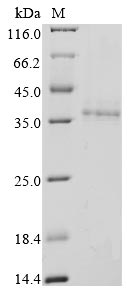This recombinant Bovine coronavirus Non-structural protein 2a gets expressed in a baculovirus system and contains the complete protein sequence spanning amino acids 1 to 278. The protein comes with a C-terminal 6xHis-tag, which makes purification and detection more straightforward. SDS-PAGE analysis confirms the protein reaches over 85% purity, which should deliver reliable results for research work.
Non-structural protein 2a appears to be crucial for how Bovine coronavirus handles replication and transcription. The protein seems to have a significant role in the viral life cycle, positioning it as an important target for researchers trying to understand coronavirus biology. Scientists studying viral pathogenesis and exploring potential therapeutic approaches may find this protein particularly valuable.
Potential Applications
Note: The applications listed below are based on what we know about this protein's biological functions, published research, and experience from experts in the field. However, we haven't fully tested all of these applications ourselves yet. We'd recommend running some preliminary tests first to make sure they work for your specific research goals.
The protein is expressed in a baculovirus system, which supports native-like folding and PTMs—critical for bovine coronavirus non-structural protein 2a (NSP2a) function. Full-length expression (1–278 aa) preserves all potential functional domains, and the C-terminal 6xHis tag minimally disrupts structure. Baculovirus systems reliably produce correctly folded viral NSPs, but no direct validation of folding (e.g., circular dichroism for secondary structure, thermal shift assays for stability) or native bioactivity (e.g., binding to other NSPs [NSP1/NSP3], host factors, or participation in replication complexes) is provided. While folding is likely competent, bioactivity remains unconfirmed—limiting definitive claims about its role in viral replication.
1. Antibody Development and Immunological Studies
This recombinant BCoV NSP2a can serve as an antigen for generating monoclonal/polyclonal antibodies, and the C-terminal His tag simplifies purification/immobilization. However, antibody specificity must be validated against native NSP2a—baculovirus expression may present non-native epitopes, leading to cross-reactivity. The full length provides thorough epitope coverage, but ELISA/Western blot results require confirmation with native protein or infected cells to ensure relevance.
2. Protein-Protein Interaction Studies
Pull-down assays using the His tag can identify cellular/viral interactors, but results depend on correct folding—misfolded NSP2a may yield false positives/negatives. Identified partners must be validated via co-IP or functional assays (e.g., replicon assays) to rule out artifacts. The full length supports domain-specific interaction mapping, but bioactivity (e.g., binding to NSP3) is unconfirmed.
3. Biochemical Characterization and Enzymatic Assays
This protein supports preliminary biophysical studies (e.g., circular dichroism for secondary structure, dynamic light scattering for stability) and biochemical assays (e.g., thermal shift for stability). Baculovirus expression suggests native-like folding, but the His tag may interfere with enzymatic assays—tag cleavage (via protease) may improve results. Enzymatic functions (e.g., if NSP2a has helicase/protease activity) must be explicitly validated.
4. Viral Protein Localization and Trafficking Studies
Cell-based assays (e.g., transfection of insect/mammalian cells with the construct) can investigate localization, but results require validation of native folding—misfolded NSP2a may mislocalize. Immunofluorescence using anti-His antibodies can track distribution, but co-staining with organelle markers (e.g., ER/Golgi) is needed to confirm trafficking. The full length preserves localization signals, but functionality (e.g., replication complex assembly) must be assessed via co-localization with other NSPs.
Final Recommendation & Action Plan
This baculovirus-expressed BCoV NSP2a is a viable tool for antibody development and functional studies due to its eukaryotic folding, but rigorous validation is non-negotiable first, confirm folding via circular dichroism/thermal shift assays to rule out misfolding; second, validate bioactivity (e.g., binding to NSP3 or host factors) using co-IP or replicon assays; third, for localization, use confocal microscopy to confirm subcellular distribution. Optimize expression (e.g., co-express molecular chaperones like Hsp70) if folding is impaired. If validation passes, leverage its full length for replication studies—otherwise, switch to a mammalian system (e.g., HEK293 cells) to ensure native PTMs and conformation. Always include native NSP2a controls to contextualize results and ensure downstream applications reflect true viral biology.






